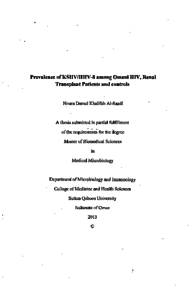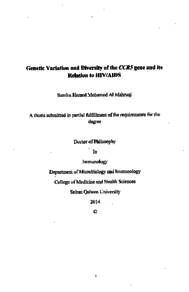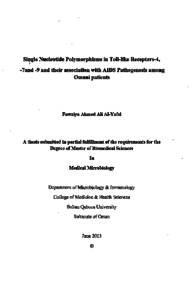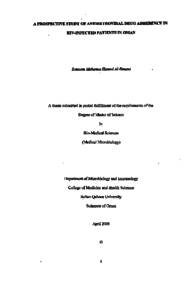وثيقة
Prevalence of KSHV/HHV-8 among Omani HIV, Renal transplant patients and controls
الناشر
Sultan Qaboos University
ميلادي
2013
اللغة
الأنجليزية
الموضوع
الملخص الإنجليزي
Human Herpes virus 8 or Kaposi Sarcoma associated Herpes Virus (HHV-8/KSHV), is the eighth member of human herpesvirus family. It is classified within gamma 2 subfamily and it can infect human with cell tropism mainly on CD19+B cell. It was discovered by Chang et al., and Moore in 1994. Many diseases were reported to be associated with HHV-8 infection. Kaposi sarcomas (KS), Primary Effusion Lymphoma (PEL) and Multicentric Castelman's Disease are the main clinical presentations that are associated with HHV-8 infection. They usually affect immunosuppressed patients such as HIV patients and organ transplant recipients. In all these clinical settings, HHV-8 is an important, but not sufficient to develop such a disease and there are many factors that contribute to HHV-8 disease development. The present study is the first to be conducted among Omani patients and controls. It aims to investigate the presence of HHV-8 infection among three different groups: HIV Infected Individuals, Renal Transplant Patients and the Control group and to consider the factors that might contribute to HHV-8 infection. In order to achieve those aims, a total of 302 paired serum and PBMCs samples (using ficol histopaque) were collected from SQUH, FAMCO and Busher Polyclinic. The 302 serum samples were tested using KSHV ELISA Kits that utilizes the whole virus lysate to investigate the presence of HHV-8 antibodies. HHV-8 viral loads were measured from 302 PBMCs samples using Real Time PCR. Moreover, HHV-8 viral loads were measured from 17 serum samples and 11 whole blood specimens that belonged to HHV-8 seropositive individuals using Real Time PCR. Among 302 tested serum samples, the overall HHV-8 seroprevalence was 5.6% in the studied population. HHV-8 was highly prevalent among HIV patients (16%) and Renal Transplant Patients (6%) compared to control group (0.71%) with an overall p value = 0.003. No significant differences were found between demographic factors such as age, gender, place of birth and residence and HHV-8 seropositivity. Furthermore, no significant differences were found between clinical data for HIV or Renal transplant patients such as CD4 counts, HIV viral loads, and type of antiretroviral therapy, frequency of hemodialysis, date and place of transplantation, type of donors (cadaver, relative/non-relative), HBV, HCV and type of immunosuppressive therapy. The prevalence of HHV-8 DNA isolated from PBMCs was 3.2% (2/62) among HIV patients, 1% (1/100) among renal transplant patients compared to zero % (0/140) in the control group. Only one serum sample was shown to be positive to HHV-8 DNA which belonged to a renal transplant patient who previously was diagnosed with Kaposi Sarcoma and none of the whole blood samples showed positivity to HHV-8 DNA. According to the results obtained from this study, KSHV/HHV-8 appears to be not ubiquitous or in other words the virus is rarely found among the Omani population. Therefore, Oman could be classified as a low prevalence area for HHV-8. Serological and molecular screening of donors might be of a critical value especially in endemic areas of HHV-8. While screening of HIV patients could play role in identifying patients who are at risk of developing KS and also helpful in monitoring those patients clinically and to provide a better life quality. Moreover, increasing awareness, education, trainings and successful implementation of infection control rules among patients and staff could help in reducing if not eliminating HHV-8 transmission and hence interrupting the virus infection.
الوصف
Thesis
المجموعة
URL المصدر
الملخص العربي
المناعي المكتسب (HIV patients) من مستشفى جامعة السلطان قابوس و140 شخص سليم من بنك الدم ومن المجمع الصحي (FAMCO) بجامعة السلطان قابوس حيث تم جمع جميع بيانات المرضى الديموغرافية والاكلينكيه من خلال الاستبيان و المقابلات الشخصيه اومن خال البيانات الموجوده في السجلات الطبيه. حيث شملت الدراسة 604 عينة عشوائية من المرضى والأشخاص الأصحاء أعلاه. أذ تم جمع 302 عينه من خلايا الدم المحيطية وحيدة النواة (PBMCs) و 302 عينة مصل. وللكشف عن وجود مضادات الحلا تم فحص 302 عينة مصل باستخدام طريقة مقایسة الممتز المناعي المرتبط بالانزيم (ELISA) وللكشف عن الحمل الفيروسي لفيروس الحلا تم فحص 302 عينه من خلايا الدم المحيطيه وحيدة النواه بالاضافه الى 17 عينة مصل و11 عينة دم كاملة والتي تنتمي الى المرضى أو الأشخاص الأصحاء ذوالمصل الموجب لمضادات الحلا عن طريق استخدام تقنية أنزيم بلمرة التفاعل المتسلسل ( RT - PCR ). أظهرت نتائج البحث عن وجود مضادات الحلا في 17 ((5.6% عينه من مجموع 302 عينة مصل. كما بينت الدراسة أن 10 عينات منها تنتمي الى مرضى متلازمة العوز المناعي المكتسب (HIV patients) بنسبة (16%) و6 عينات تنتمي الى مرضى زراعة الكلى بنسبة (6%) مقارنة بعينه واحده تنتمي للاشخاص الاصحاء بنسبة ( . 71 %) مع وجود فارق إحصائي وكانت القيمة البائيه تساوي ( 0 , 003 = p - value). ولدراسه العوامل المساعده في انتشار فيروس الحلا تمت مقارنه العوامل الديموغرافيه كالعمر والجنس و الحاله الاجتماعيه ومكان الميلاد والإقامة . أما العوامل الاكلينكيه مثل مكان وتاريخ زراعة الكلى وعدد مرات التعرض للغسيل الكلوي ونوع المتبرع (اذا كان من العضو المتبرع به شخص حي او ميت أو اذا كان من الأقارب أو من غير الاقارب ونوع مضادات المناعة المستخدمه في العلاج ومستوى الخلايا النائية من نوع CD4 ومقدار الحمل لفيروس متلازمة العوز المناعي المكتسب ونوع الأدوية المستخدمة لعلاج متلازمة العوز المناعي المكتسب والإصابة بفيروس التهاب الكبد الوبائي ب اوج مع الأشخاص والمرضى الموجبين المضادات الحلا. أظهرت النتائج أنه ليس هناك فروق احصائيه بين هذة العوامل ووجود مضادات الحلا كما كشفت الدراسة عن وجود الحمض النووي لفيروس الحلا في ثلاثة مرضى، حيث أوضحت الدراسه ان نسبه وجود فيروس الحلا في مرضى متلازمة العوز المناعي المكتسب (3.2%) ونسبة وجوده في مرضی زراعة الكلى (1%) ولم يتم الكشف عن وجود الحمض النووي لفيروس الحلا في عينات الأشخاص الأصحاء. أما بالنسبة لنوع العينات التي تم الكشف فيها عن وجود الحمض النووي لفيروس الحلا فقد كانت كالتالي 3 عينات من خلايا الدم المحيطيه وحيده النواه وعينه مصل واحده ولم يتم الكشف عن وجود الحمض النووي للفيروس في عينات الدم الكاملة. من خلال هذة الدراسه نستخلص ان فيروس الحلا غير شائع بين العمانيين. ونتيجة لذلك فإنه يمكن تصنيف سلطنة عمان كإحدى الدول التي يعد وجود الفيروس بها قليل الانتشار. كما أن هذة الدراسه توصي بانه من الضروري فحص الأشخاص الأصحاء في الدول التي يتواجد فيها
قالب العنصر
الرسائل والأطروحات الجامعية




